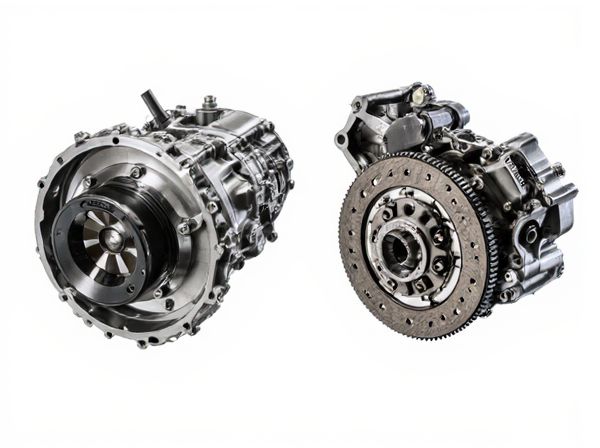
Photo illustration: Centrifugal Clutch Transmission vs Hydraulic Clutch Transmission
Centrifugal clutch transmissions engage automatically based on engine speed, providing smooth acceleration without manual input, making them ideal for beginner riders and lightweight vehicles. Hydraulic clutch transmissions offer precise control and consistent power transfer through fluid pressure, enhancing performance and durability in high-torque applications. Understanding these differences helps you select the clutch system that best matches your vehicle's demands and driving preferences.
Table of Comparison
| Feature | Centrifugal Clutch Transmission | Hydraulic Clutch Transmission |
|---|---|---|
| Operation | Engages automatically based on engine RPM using centrifugal force. | Engages via hydraulic fluid pressure controlled by clutch pedal. |
| Maintenance | Low maintenance; fewer components prone to wear. | Requires regular hydraulic fluid checks and possible bleeding. |
| Control | Less driver control; automatic engagement. | Full driver control over clutch engagement and disengagement. |
| Durability | Durable in low to moderate torque applications. | Better suited for high torque and heavy-duty use. |
| Cost | Lower initial cost and simpler design. | Higher cost due to complex hydraulic components. |
| Common Usage | Small motorcycles, go-karts, light vehicles. | Cars, trucks, motorcycles requiring precise clutch control. |
Introduction to Clutch Transmission Systems
Centrifugal clutch transmission relies on centrifugal force to engage the clutch as engine speed increases, offering automatic engagement without direct rider input. Hydraulic clutch transmission uses fluid pressure to control clutch engagement, providing smoother and more precise operation through a hydraulic master-slave cylinder system. Both systems serve to transfer engine power to the drivetrain but differ significantly in mechanism, control, and application efficiency.
Overview of Centrifugal Clutch Transmission
Centrifugal clutch transmissions use centrifugal force to automatically engage and disengage the clutch based on engine speed, providing smooth power transfer without manual input. This type of transmission is commonly found in small motorcycles, go-karts, and lawn equipment due to its simplicity and low maintenance requirements. Its design allows for seamless acceleration and prevents engine stalling by engaging the clutch gradually as RPM increases.
Overview of Hydraulic Clutch Transmission
Hydraulic Clutch Transmission utilizes fluid pressure to engage and disengage the clutch, offering smoother and more precise control compared to mechanical linkages. This system enhances driving comfort by reducing pedal effort and providing consistent clutch operation, especially under variable load conditions. Its reliability and ease of maintenance make it a preferred choice in modern vehicles seeking improved performance and driver experience.
Key Mechanisms: How Centrifugal Clutches Work
Centrifugal clutch transmission operates by using centrifugal force to engage the clutch automatically as engine speed increases, allowing smooth and gradual power transfer without manual intervention. Weights inside the clutch drum move outward due to engine rotation, pressing friction shoes against the drum to transmit torque. This mechanism contrasts with hydraulic clutch transmission, which relies on fluid pressure to actuate the clutch, requiring manual control for engagement and disengagement.
Key Mechanisms: How Hydraulic Clutches Work
Hydraulic clutch transmissions operate using fluid pressure to engage and disengage the clutch mechanism, providing smoother and more precise control compared to centrifugal clutches, which rely on centrifugal force to activate. In hydraulic systems, a master cylinder generates pressure that is transmitted via brake fluid to a slave cylinder, which then actuates the clutch release bearing. This mechanism offers consistent pedal feel, reduced driver effort, and better modulation, making hydraulic clutches preferred for vehicles requiring refined control and durability.
Performance Comparison: Response and Efficiency
Centrifugal clutch transmissions offer quicker engagement and smoother acceleration due to their automatic response based on engine speed, making them ideal for low to medium power applications. Hydraulic clutch transmissions provide superior control and precise modulation of power transfer, resulting in higher efficiency and smoother shifting under varying loads. While centrifugal clutches excel in simplicity and low maintenance, hydraulic systems outperform in performance responsiveness and energy efficiency in high-demand scenarios.
Maintenance and Durability Considerations
Centrifugal clutch transmissions typically require less frequent maintenance due to their simple mechanical design and automatic engagement, reducing wear on components. Hydraulic clutch transmissions demand regular inspection of fluid levels, periodic bleeding to prevent air bubbles, and seal replacements to maintain optimal performance. Durability in centrifugal clutches is often higher for low-power applications, while hydraulic clutches excel in high-torque environments due to better control and smoother power transfer.
Applications: Where Each System Excels
Centrifugal clutch transmissions excel in applications requiring automatic engagement and smooth power transfer at varying engine speeds, such as scooters, go-karts, and small motorcycles, where simplicity and low maintenance are critical. Hydraulic clutch transmissions are preferred in heavy-duty vehicles and motorcycles demanding precise manual control, high torque capacity, and consistent performance under varying load conditions, including trucks, sports motorcycles, and industrial machinery. The choice between these systems depends on the need for automatic versus manual operation, torque handling requirements, and the operational environment.
Cost and Installation Differences
Centrifugal clutch transmissions generally cost less and offer simpler installation compared to hydraulic clutch transmissions, making them ideal for lightweight machinery and budget-sensitive projects. Hydraulic clutch transmissions, while more expensive, provide smoother engagement and greater control, requiring more complex installation with precise hydraulic fluid management. The choice between the two hinges on balancing initial cost savings of centrifugal systems against the durability and performance advantages of hydraulic systems.
Choosing the Right Clutch Transmission for Your Needs
Selecting the right clutch transmission depends on your vehicle's performance requirements and maintenance preferences. Centrifugal clutch transmissions offer smooth automatic engagement ideal for low-speed or beginner-friendly applications, while hydraulic clutch transmissions provide precise control and durability suitable for high-performance and heavy-duty vehicles. Consider factors such as ease of use, response time, and maintenance frequency to match the clutch system with your driving style and operational demands.
 caratoz.com
caratoz.com